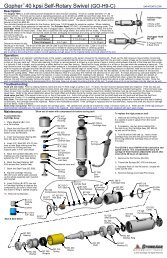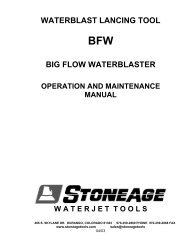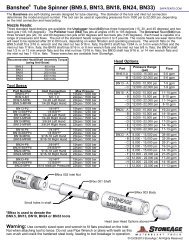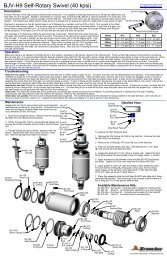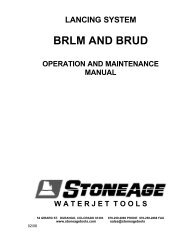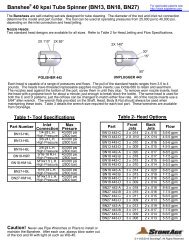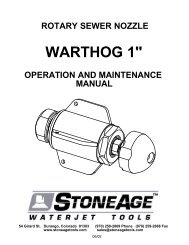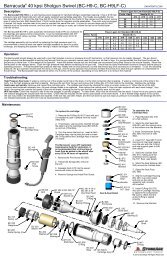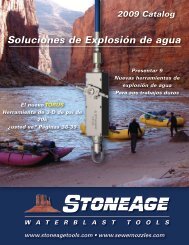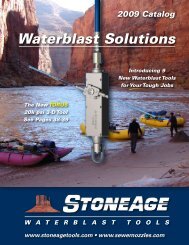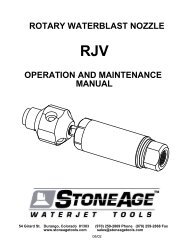View PDF - StoneAge Inc
View PDF - StoneAge Inc
View PDF - StoneAge Inc
Create successful ePaper yourself
Turn your PDF publications into a flip-book with our unique Google optimized e-Paper software.
Nozzle Performance in Rotary Applications - Summary<br />
Nine different nozzle designs were tested. The three best are<br />
discussed below. Call us for a copy of the complete paper.<br />
Nozzle performance depends greatly on inlet conditions. Any<br />
abrupt change of flow direction, or velocity creates turbulence and<br />
diminishes jet power. Waterjets lose power as standoff distance<br />
increases - approximately 35% is lost 500 orifice diameters away<br />
from the nozzle. The loss grows to as much as 60% with turbulent<br />
inlet conditions. At greater standoff, controlling turbulence can mean<br />
as much as a ten-fold increase in cleaning power.<br />
Turbulent inlet flow is common in the industry because of<br />
practical access situations that limit the size and geometry of<br />
jetting tools. Four techniques for improving inlet flow conditions<br />
were tested - inlet nozzle extensions, vane type insert, screen,<br />
and cone inserts. The screen and cone inserts were not effective<br />
at the conditions tested, but are believed to be more effective at<br />
higher flows. Most effective were extension nipples which<br />
provided a straight flow inlet to the nozzle. A length equivalent to<br />
20 flow channel diameters provides over 90% of the maximum<br />
possible improvement. Of course, it is not always possible to use<br />
New Tools<br />
extensions due to space limitations. That’s when a vane insert can<br />
be most helpful. A single vane insert improved nozzle performance<br />
by 40%, a level still 25% below that with good, nonturbulent<br />
inlet conditions.<br />
Nozzle comparisons made with good, non-turbulent inlet flow,<br />
show Nozzle “I” to be the best performer of the ten tested. This<br />
design uses a long converging cone, and inlet extension 8<br />
diameters long, with ID closely matching the cone inlet. With good<br />
non-turbulent inlet flow, Nozzle “B” performance was almost<br />
equivalent to “I” . With turbulent inlet flow, Nozzle A proved to<br />
perform substantially better than any other nozzle due to its<br />
effective vane insert . In fact, even with good non-turbulent inlet<br />
flow, Nozzle “A” performed within 10% of the best.<br />
WH & WG 085<br />
Super Centralizers<br />
For the Warthog Sewer Nozzles,<br />
lines bigger than 6 in. diameter, where<br />
severe blockage is present - the Super<br />
Centralizer is ready! By keeping<br />
the Warthog back a few inches from<br />
the plug, the front jet does a better job.<br />
2-1/4 in. Ø<br />
SH Swivel<br />
2-D BJV-H Nozzle<br />
Because our customers asked for it,<br />
this new hose handling swivel was developed.<br />
It only weighs 1 lb 14 oz. with<br />
Very High Flow<br />
This new model of <strong>StoneAge</strong>’s most popular 1/2 npt inlet and outlet ports. It handles<br />
tool handles up to 175 gpm at 10 Kpsi for up to 60 gpm at 15 Kpsi with only 13<br />
thick deposits, large vessels or boiler cleaning.<br />
Like other BJV models, all the standard dling swivel for shotgun operations.<br />
in-lb of torque. It is the ideal hose han-<br />
heads and centralizers fit the BJV-H.<br />
O C 8/99<br />
W A T E R J E T T O O L S<br />
970-259-2869 Phone 970-259-2868 FAX<br />
® http://www.stoneagetools.com



